Egypt’s flag, a symbol interwoven with the nation’s vast historical tapestry and forward-looking ethos, captures the essence of its cultural and historical journey and reflects Egypt’s transition from ancient marvels to contemporary advancements.
Flag of Egypt

The flag of Egypt presents a bold and distinct design characterized by three horizontal bands. Central to its striking appearance is the emblem of the Eagle of Saladin, rendered in gold, which rests in the middle band.
This emblem, a symbol of strength and sovereignty, is a significant aspect of the flag, connecting Egypt’s present to its prosperous past and heritage.
Flag of Egypt: Color Palette
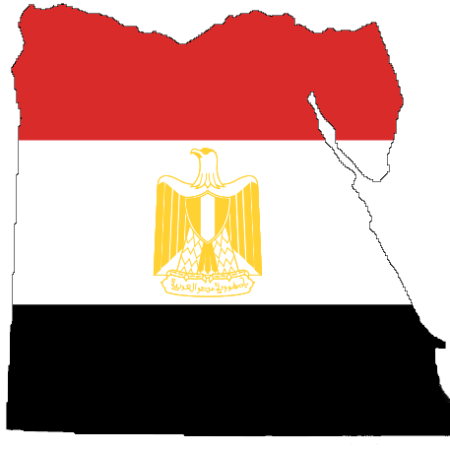
Egypt Flag Emoji: 🇪🇬
The color palette of Egypt’s flag is both symbolic and visually striking, composed of distinct colors holding deep meaning within the nation’s character and context. These colors are not just aesthetic choices but a reflection of Egypt’s values.
Meaning of Each Color
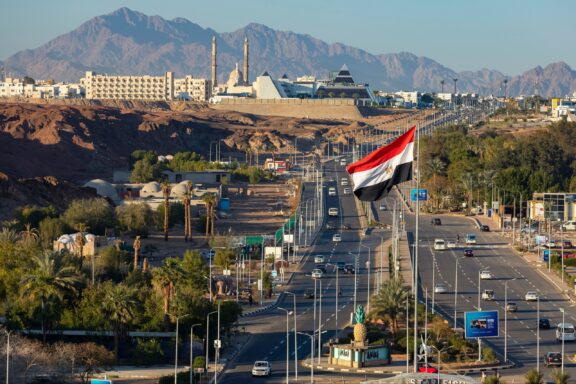
Red
The top band of red in Egypt’s flag symbolizes the nation’s struggle against British occupation. This color embodies the courage and sacrifices made by Egyptians in their pursuit of independence and self-determination.
Beyond its representation of resistance, red in Egypt’s flag also symbolizes the vitality and strength of the Egyptian spirit in overcoming adversity.
White
The white middle band represents the bright and hopeful future of Egypt. It signifies the peaceful transition from monarchy to a republic, achieved without bloodshed, symbolizing a new era of optimism and progress.
While illustrating a peaceful future, the white band also conveys a message of purity and unity, integral to the nation’s identity in its new era.
Black
The bottom black band reflects the period of oppression and occupation. It is a reminder of the dark times endured under foreign rule and the monarchy, symbolizing the resilience and fortitude of the Egyptian people in overcoming these challenges.
Black, symbolizing past oppression, also stands as a stark reminder of the resilience and enduring spirit of Egyptians through challenging historical epochs.
Egypt’s Coat of Arms

The coat of arms of Egypt, symbolized by the Eagle of Saladin, is a poignant emblem, resonating with themes of resilience, supremacy, and the transformative journey through the annals of time.
This emblem underscores Egypt’s central role in the narrative of Arab nationalism and its history of revolution and change, and it’s historically linked to the recapturing of Jerusalem and Arab unity, resonating with the spirit of the Egyptian Revolution of 1952, a pivotal moment in the nation’s history.
By encompassing these elements, this coat of arms represents Egypt’s enduring legacy, aspirations for sovereignty, and influential position within the broader Arab narrative.
Historical Evolution and the Meaning Behind Changes
The evolution of Egypt’s flag is deeply intertwined with its political and cultural shifts. Initially, Egypt’s flags often bore Islamic and Ottoman motifs, reflecting its historical affiliations. However, significant changes began in the 20th century.
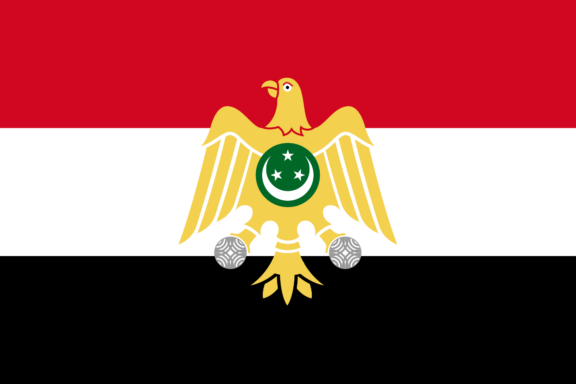
During the monarchy period under British rule, the flag incorporated green, symbolizing the ruling dynasty and Egypt’s agricultural richness. The revolution of 1952 marked a decisive shift, introducing the current red, white, and black scheme – the colors of the Arab Liberation Flag.
This change symbolized a break from the monarchical and colonial past, with each color representing a different aspect of Egypt’s revolutionary journey: red for the struggle against British rule, white for the peaceful transition of power, and black for the end of oppression.

These colors have since remained, symbolizing Egypt’s modern identity and role in the broader Arab world. Incorporating the Eagle of Saladin in the flag, a powerful symbol of Arab nationalism, further solidified its current form, connecting Egypt’s past with its contemporary national identity.
Overall Symbolic Meaning of the Flag
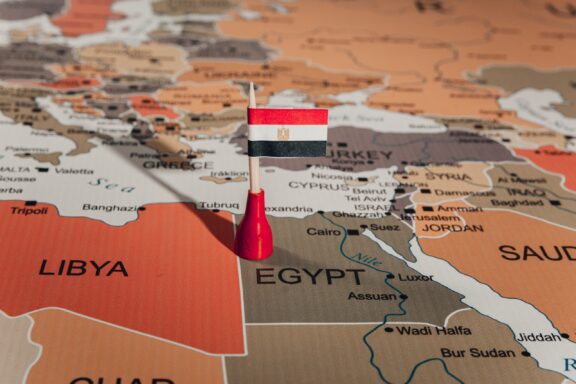
The flag of Egypt, with its distinct red, white, and black bands, collectively narrates a story of resilience, transformation, and optimism. It merges the legacy of the struggle for independence, the peaceful emergence of a new republic, and the end of a period of darkness and oppression.
Similar Flags to the Flag of Egypt
Several national flags resemble Egypt’s, reflecting shared historical narratives and cultural ties within the Arab world. Here are some notable examples:
Iraq
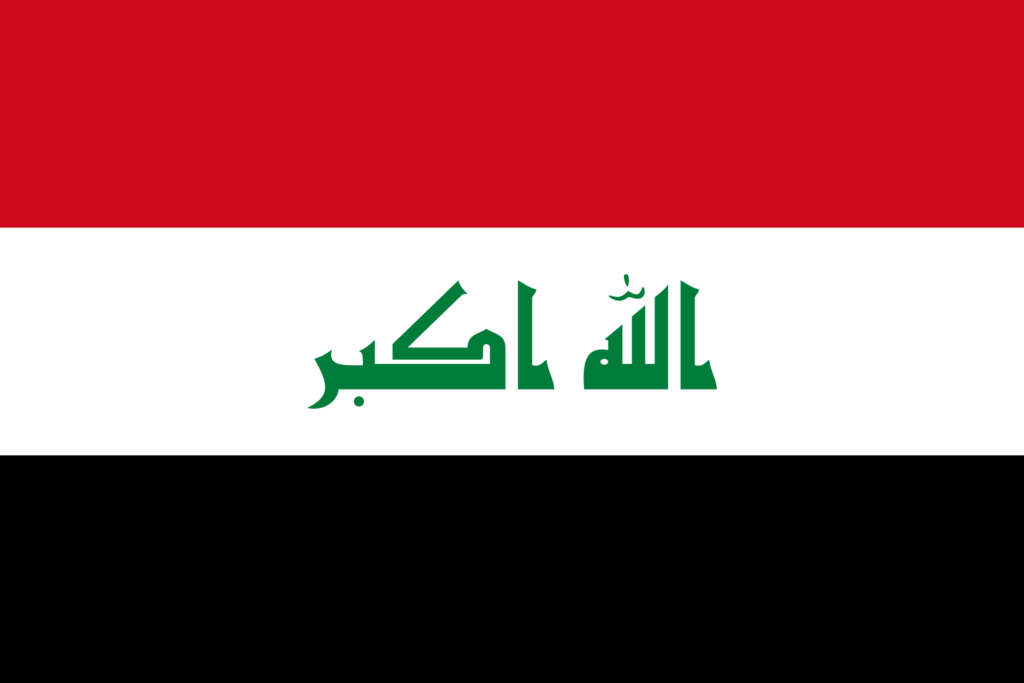
The flag of Iraq also features the Pan-Arab colors of red, white, and black. This similarity stems from the shared Arab identity and historical connections within the region. These colors symbolize a shared commitment and the collective journey toward sovereignty.
Yemen

Yemen’s flag, like Egypt’s, consists of horizontal red, white, and black bands. The resemblance is rooted in their common Arab heritage and the Pan-Arab nationalist movement that influenced flag designs in the mid-20th century and representation of the shared aspirations and historical experiences of the Arab people.
Syria

Syria’s flag, while incorporating green, also has red, white, and black colors. The design reflects a shared history of Arab nationalism and the struggle for independence from colonial powers. Its similar color scheme reflects a common narrative of resilience and the pursuit of Arab nationalism, akin to Egypt’s experience.
Conclusion
Egypt’s flag symbolizes the nation’s extended past, unity, and forward-looking vision. It stands as a distinct emblem in the world of flags and embodies a sense of pride and collective identity for Egyptians.
Image Sources and Copyright Information
- Sharm El Sheikh, Egypt with Flag: © Alexey Smyshlyaev/Shutterstock
- Egyptian Flag Pin on Map Indicating Egypt’s Location: © GR.Stocks/Shuttesrtock